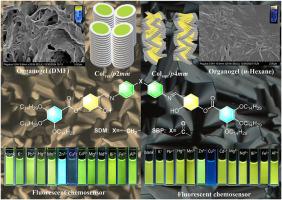具有二苯甲烷或二苯甲酮核心和水杨醛二胺臂的弯核六烷基液晶:自组装和双模态荧光探针
IF 4.2
3区 工程技术
Q2 CHEMISTRY, APPLIED
引用次数: 0
摘要
本研究研究了两种新型弯核水杨醛二胺六萜液晶SDM和SBP,重点研究了它们的自组装模式和多功能性,这些自组装模式和多功能性是通过其中心核的结构分化来调节的。SDM中的二苯基甲烷核通过两分子形成的二聚体的倾斜堆叠形成矩形柱状相(Colrec/p2mm),而具有二苯甲酮核的SBP由于分子之间的强极性和偶极-偶极相互作用,形成了高度对称的方形柱状相(Colsqu/p4mm),液晶相范围更广,热稳定性增强。SDM和SBP分别在N, N-二甲基甲酰胺(DMF)和正己烷中形成有机凝胶。光物理研究表明,这两种化合物都表现出激发态分子内质子转移(ESIPT)、显著的Stokes位移和聚集诱导发射(AIE)效应的特征。此外,SDM可以作为双通道荧光探针,同时识别Cu2+和Zn2+,实现“开-关”双模态响应,克服了传统希夫碱单离子探针的局限性。本文章由计算机程序翻译,如有差异,请以英文原文为准。

Bent-core hexacatenar liquid crystals with diphenylmethane or benzophenone core and salicylaldimine arms: Self-assembly and dual-modality fluorescence probe
This study investigates two novel bent-core salicylaldimine hexacatenar liquid crystals, SDM and SBP, focusing on their self-assembly modes and multifunctionality, which are modulated through the structural differentiation of their central cores. The diphenylmethane core in SDM enables the formation of a rectangular columnar phase (Colrec/p2mm) through tilted stacking of dimer formed by two molecules, while SBP with a benzophenone core, forms a highly symmetric square columnar phase (Colsqu/p4mm) with a broader liquid crystal phase range and enhanced thermal stability due to the strong polarity and dipole-dipole interactions between molecules. Moreover, SDM and SBP can form organogels in N, N-dimethylformamide (DMF) and n-hexane, respectively. Photophysical investigations reveal that both compounds exhibit characteristics of excited state intramolecular proton transfer (ESIPT), significant Stokes shifts, and aggregation-induced emission (AIE) effects. Furthermore, SDM can serve as a dual-channel fluorescent probe that enables and simultaneous recognition of Cu2+ and Zn2+ to achieve an “on-off” dual-modality response, overcoming the limitations of traditional Schiff base-based single-ion probes.
求助全文
通过发布文献求助,成功后即可免费获取论文全文。
去求助
来源期刊

Dyes and Pigments
工程技术-材料科学:纺织
CiteScore
8.20
自引率
13.30%
发文量
933
审稿时长
33 days
期刊介绍:
Dyes and Pigments covers the scientific and technical aspects of the chemistry and physics of dyes, pigments and their intermediates. Emphasis is placed on the properties of the colouring matters themselves rather than on their applications or the system in which they may be applied.
Thus the journal accepts research and review papers on the synthesis of dyes, pigments and intermediates, their physical or chemical properties, e.g. spectroscopic, surface, solution or solid state characteristics, the physical aspects of their preparation, e.g. precipitation, nucleation and growth, crystal formation, liquid crystalline characteristics, their photochemical, ecological or biological properties and the relationship between colour and chemical constitution. However, papers are considered which deal with the more fundamental aspects of colourant application and of the interactions of colourants with substrates or media.
The journal will interest a wide variety of workers in a range of disciplines whose work involves dyes, pigments and their intermediates, and provides a platform for investigators with common interests but diverse fields of activity such as cosmetics, reprographics, dye and pigment synthesis, medical research, polymers, etc.
 求助内容:
求助内容: 应助结果提醒方式:
应助结果提醒方式:


